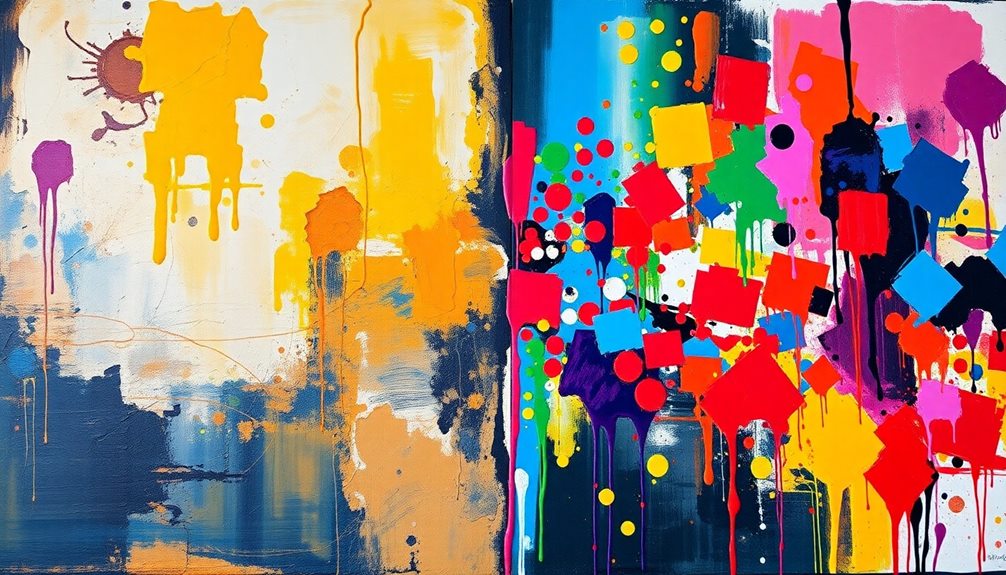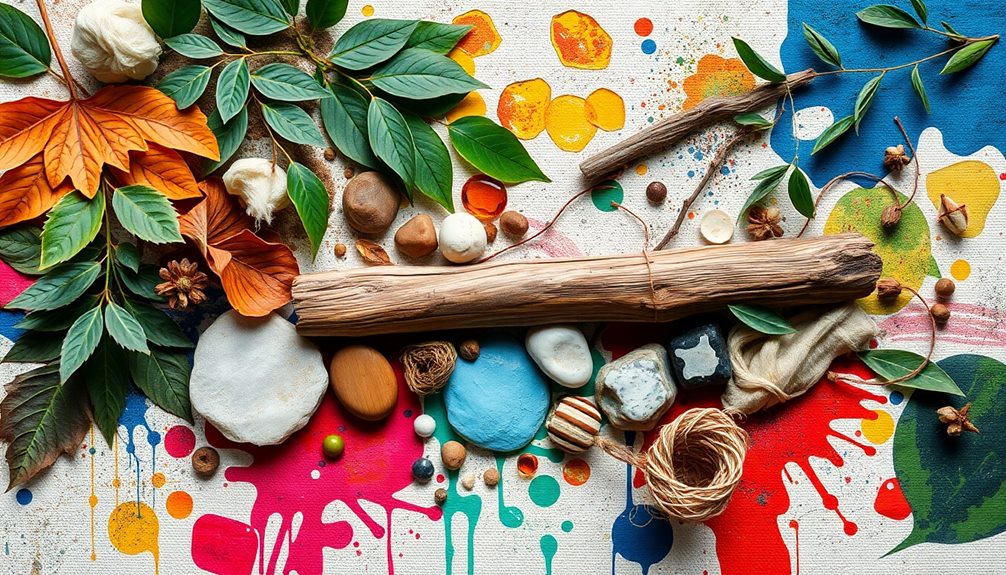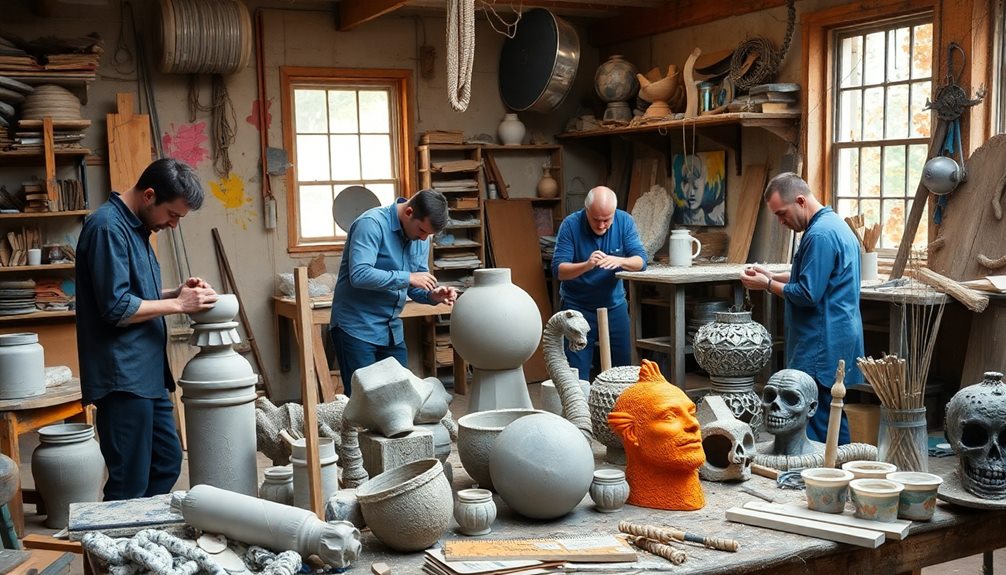Contemporary art materials and methods challenge traditional boundaries, blending experimentation with the familiar. You'll see artists using everyday items, like those from the Arte Povera movement, to make profound statements about culture and identity. Techniques range from traditional craftsmanship to innovative approaches involving found objects and textiles. Material choices bring emotional resonance, engaging viewers on a deeper level. The use of natural elements and ephemeral materials further enriches the sensory experience of art. To truly appreciate how these materials shape contemporary narratives and practices, you might want to explore the diverse methods artists employ today.
Key Takeaways
- Contemporary artists utilize unconventional materials, such as found objects, to challenge traditional notions of art and enhance viewer engagement.
- The emotional impact of artworks is shaped by material selection, with tactile qualities fostering deeper connections and narratives.
- Movements like Arte Povera emphasize the beauty of ordinary materials, promoting spontaneity and reflection on consumerism and material culture.
- Integration of natural elements in art addresses environmental themes, creating dialogue about humanity's relationship with nature.
- Community engagement in art fosters collaboration, enriching artistic processes and promoting shared creativity among diverse audiences.
Importance of Art Materials

Art materials play an essential role in your artistic journey, shaping both the creation and the interpretation of your work. The importance of art materials can't be overstated, as they define the physical composition of your pieces and influence your choices based on their unique properties.
When you select a material, you're not just picking something to work with; you're choosing a medium that carries its own historical context and emotional weight.
Contemporary artists are pushing the boundaries by experimenting with unexpected materials, including everyday objects, textiles, and various natural materials. This shift, especially prominent in the 20th century, has led to innovative artistic outcomes that challenge traditional norms.
By utilizing diverse substances, you can provoke thought and enhance viewer engagement, making your art resonate on multiple levels.
The interplay between materials and concepts remains crucial. Each material contributes to the narrative and cultural relevance of your work, countering the trend of purely conceptual art.
As you explore different art materials, you'll discover how they shape not just your artistic expression but also the experience and interpretation of your audience.
Traditional vs. Contemporary Techniques

When examining the distinction between traditional and contemporary techniques, you'll find a rich tapestry of methods that reflect both cultural heritage and modern innovation. Traditional techniques, such as handweaving, embroidery, and stone carving, emphasize craftsmanship and the historical significance of materials. These methods have been passed down through generations, showcasing the cultural narratives of artisans.
Additionally, materials like butter have been used in traditional artistic expressions, highlighting their cultural significance and historical context, as seen in butter's malleability which allows for intricate artistic designs.
In contrast, contemporary techniques challenge these traditional notions of art. Artists today often use readymades and found objects, incorporating everyday materials into their work. This shift highlights innovation and conceptual exploration, making art more accessible and relatable. The 20th century marked a pivotal moment, with artists like Picasso integrating unconventional materials, such as newspaper and fabric, thereby blurring the lines between high and low art.
Contemporary artists, such as Amanda Valdez, adapt traditional textile methods to craft large-scale installations that engage with themes of identity and memory. This interplay between traditional craftsmanship and contemporary experimentation allows artists to reinterpret and revitalize historical techniques within modern contexts.
Exploration of Unconventional Materials

Innovation in contemporary art often springs from the daring exploration of unconventional materials, pushing boundaries and redefining artistic expression. Artists like Picasso and the Cubists first integrated everyday items, such as newspapers and fabrics, to create texture in their work. This pioneering spirit laid the groundwork for movements like Arte Povera in the 1960s, which emphasized inexpensive and unconventional materials, challenging traditional notions of art and commercialization.
By incorporating found objects and natural elements, these artists invited you to rethink the very essence of art.
Today, contemporary artists, such as Helen Marten, merge handmade and found objects in intricate installations, prompting you to closely examine your surroundings and the materials within them. Similarly, Niki de Saint Phalle's unique approach—shooting paint onto canvases—showcases how unconventional techniques can lead to spontaneity and playfulness in artistic practice.
The use of unconventional materials not only inspires innovation but also encourages you to explore new forms of expression. This exploration blurs the lines between art and everyday life, provoking thought about consumerism and material culture in our modern world.
Cultural Significance of Materials

Artists' choices in materials often reveal rich cultural narratives and histories, offering deeper insights into their work. By utilizing everyday objects, they connect their art to broader social contexts, enhancing their cultural intelligence (CQ) in the process.
For instance, Sheela Gowda's "Behold" employs steel car bumpers and knotted human hair to symbolize complex identities in Indian culture. Similarly, Khader Attia's "Untitled (Ghardaíá)" made from couscous illustrates how such materials can embody cultural heritage.
Theaster Gates uses recycled items in works like "Civil Tapestry," critiquing historical disengagement from black culture and social issues. These materials become symbolic, transforming mundane objects into powerful statements about identity and experience.
Additionally, the ability to adapt and respond to the cultural significance of these materials reflects a high level of cultural competence that can foster collaboration and understanding in diverse artistic communities.
Teresa Margolles also highlights the significance of materials, provoking thought on social issues through her art.
Through these examples, it's clear that the cultural significance of materials in contemporary art goes beyond aesthetic choices; they act as conduits for cultural narratives. By engaging with these materials, you not only appreciate the art but also the complex stories and histories they carry, offering a richer understanding of the world around you.
Material Selection and Emotional Impact

The emotional resonance of contemporary art often hinges on the materials artists choose to work with. Your understanding of an artwork can deepen markedly when you consider the historical context of the materials selected. Each material carries its own narrative, influencing your emotional response.
For instance, the tactile qualities of a piece—whether it's the smoothness of polished wood or the roughness of reclaimed metal—can evoke distinct sensory experiences that resonate differently with you.
Contemporary artists frequently experiment with unconventional materials, such as found objects or textiles, to challenge traditional perceptions and create innovative emotional connections. Take Diedrick Brackens, for example; his use of cotton in tapestries symbolizes historical burdens, inviting you to engage more deeply with Black American heritage.
Similarly, artists like Teresa Margolles choose specific materials to provoke thought and engage viewers on emotional and cultural levels. Ultimately, material selection isn't just about aesthetics; it's a deliberate choice that shapes how you connect with the artwork.
Innovative Approaches to Art Making

Contemporary art thrives on fresh perspectives, with many creators embracing unconventional approaches to their craft. Artists today often utilize different materials, including found objects and textiles, to challenge traditional perceptions of what art can be. Movements like Arte Povera exemplify this shift, encouraging you to see beauty in the ordinary.
Take Helen Marten, for example. She skillfully blends handmade and found materials in her intricate installations, prompting you to examine your surroundings and reconsider the objects you encounter daily.
Techniques such as photomontage and silk screening have also gained traction, allowing artists to weave together photographic and printmaking methods to create layered narratives.
Moreover, artists like Susan Philipsz push boundaries by incorporating ephemeral materials like sound and air, engaging your senses in ways that traditional art often doesn't.
Collaborative processes, highlighted by artists like Amanda Valdez, emphasize community engagement and shared creativity, showcasing how different perspectives can enrich the artistic journey.
Natural Elements in Contemporary Art

Incorporating natural elements into art can transform your perception of both the artwork and the environment. Contemporary artists are increasingly using materials including soil, plants, and water to address themes of environmentalism and sustainability.
This approach challenges traditional notions of permanence and invites you to engage with the sensory qualities of nature.
- Richard Long's "Waterfall Line" utilizes stones to create site-specific sculptures that highlight the transient relationship between art and nature.
- Bruce McLean's "Floataway Sculpture" emphasizes the ephemeral quality of natural materials, sparking discussions about the passage of time and its environmental impact.
- Andy Goldsworthy crafts intricate installations using leaves, stones, and ice, celebrating nature's beauty while confronting its impermanence.
These works remind you of the significance of natural phenomena and our connection to the environment.
Sculptural Techniques and Manipulation

Sculpture offers a dynamic playground for artists to explore and manipulate materials in innovative ways. You'll find that sculptural techniques range from traditional methods, like bas-relief carving, to more unconventional practices that challenge the norm.
Sculptors often focus on surface manipulation, creating distinct tactile responses. For instance, Barbara Hepworth emphasizes smooth forms that evoke nature, while Barry Flanagan preserves rough textures for an organic appeal.
Experimentation plays a vital role in contemporary sculptural practices. Niki de Saint Phalle's unique approach of shooting paint showcases how breaking away from traditional methods can yield exciting results.
Artists like Sam Gilliam and Angela de la Cruz redefine the structure of their works, pushing the boundaries of what you might expect from a canvas.
Moreover, techniques like chiaroscuro allow you to create depth and drama in your sculptures, enhancing viewer engagement. This interplay between light and shadow invites emotional responses, making your work resonate on a deeper level.
Everyday Objects in Artistic Expression

When you look at contemporary art, you'll often find everyday objects transformed into powerful statements.
Artists use found materials not just for their visual appeal, but to tell stories that reflect cultural narratives and personal experiences.
This approach invites you to reconsider the significance of the ordinary in the context of artistic expression.
Found Object Aesthetics
Found object aesthetics have profoundly influenced contemporary art, transforming ordinary items into powerful tools for expression. Emerging prominently in the twentieth century, this movement invited artists to experiment with found objects and unconventional materials.
Think of how Marcel Duchamp's readymades challenged the very definition of art, while Pablo Picasso incorporated everyday materials like newspaper and metal scraps into his innovative works.
Imagine the possibilities:
- A rusty bicycle wheel reimagined as a sculpture
- Discarded toys repurposed into intricate mixed media pieces
- Vintage fabric scraps woven into a tapestry of memories
- Broken mirrors reflecting social commentary
Artists like Helen Marten exemplify this trend today, blending handmade elements with found objects to create engaging installations.
This approach encourages you to reconsider your relationship with the everyday materials surrounding you. Through these explorations, artists not only highlight the aesthetic potential of found objects but also explore cultural and historical narratives, making powerful statements about identity and memory.
As you engage with this art form, you'll discover that the most mundane items can carry profound meaning when viewed through the lens of creativity.
Cultural Narratives Through Materials
Everyday objects serve as powerful vehicles for cultural narratives in contemporary art, inviting you to explore the stories they embody. Artists experimenting with unexpected materials have different qualities that allow them to challenge traditional artistic boundaries.
For instance, Picasso's use of common materials in the Cubist movement reflects this practice, while the Arte Povera movement of the 1960s emphasized inexpensive and unconventional items to critique art commercialization.
Sheela Gowda's installation "Behold" exemplifies how materials can carry deep cultural meanings. By using steel car bumpers and knotted human hair, she symbolizes aspects of Indian culture.
Similarly, Theaster Gates repurposes reclaimed materials, like wood and bricks from abandoned buildings, to address themes of black culture and historical narratives in America.
Contemporary artists like Helen Marten blend handmade and found objects, prompting you to examine your surroundings and the cultural implications of the materials used in their work.
These artists show that everyday objects, whether industrial substances or personal artifacts, can be powerful methods for conveying rich cultural narratives, encouraging you to reflect on the stories woven into the fabric of daily life.
Evolution of Artistic Practices

Artistic practices have undergone a remarkable evolution, particularly throughout the 20th century, as artists began to explore and incorporate unconventional materials into their work. This shift allowed artists to choose materials that challenged traditional norms and emphasized concepts over craftsmanship. The advent of readymades, championed by Marcel Duchamp, sparked a dialogue around the idea behind art, leading to a reevaluation of what constitutes artistic value.
Consider these key developments:
- The rise of inexpensive materials critiquing art commercialization, as seen with Carl Andre and Dan Flavin.
- The Arte Povera movement, which utilized raw, unconventional materials to reflect socio-political themes.
- Contemporary artists like Amanda Valdez, who blend textiles with conceptual explorations.
- A growing acceptance of everyday objects as valid artistic components.
Today, artists continue to innovate, pushing boundaries with different materials and methods that bridge historical and contemporary narratives.
This evolution underscores a crucial shift in the art world, where the choice of materials becomes a powerful statement in its own right. In this landscape, the role of contemporary artists is more dynamic than ever, fostering an ongoing conversation about materiality and meaning.
Frequently Asked Questions
What Are the Materials and Techniques of Contemporary Art?
When exploring contemporary art, you'll find artists using unconventional materials like found objects and textiles. They employ techniques such as silk screening and photomontage, pushing boundaries and creating deeper narratives through innovative methods.
What Are the Art Materials Used in the Contemporary Period?
Imagine discovering a vibrant tapestry woven from discarded plastic. In contemporary art, you'll find materials like textiles, found objects, and natural elements, each chosen to provoke thought, evoke emotion, and challenge your perception of artistry.
What Are Methods and Materials in Art?
Methods in art involve techniques like painting, drawing, and sculpture, while materials range from traditional substances to found objects. You'll choose based on desired effects, meaning, and the emotions you want to convey.
What Are the 5 Forms of Contemporary Art?
You'll find five prominent forms of contemporary art: installation art, performance art, digital art, conceptual art, and street art. Each offers unique experiences and perspectives, encouraging you to engage with diverse ideas and expressions.
Conclusion
In your artistic journey, think of materials as the colors on your palette, each holding the power to evoke emotion and meaning. Just like a chef experimenting with spices, you can transform the ordinary into something extraordinary. Remember the artist who turned discarded plastic into breathtaking sculptures, reminding us of both beauty and urgency? Embrace unconventional materials, mix techniques, and let your creativity flow—after all, art's true essence lies in the stories your materials tell.









